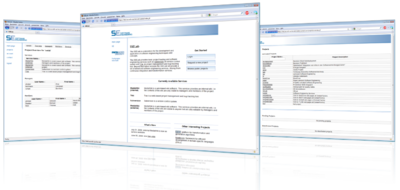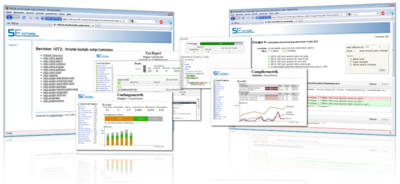
Main Page
From sselab
(→Getting Started) |
|||
| Line 12: | Line 12: | ||
== Getting Started == | == Getting Started == | ||
| - | + | If you have been invited to join a project in the SSELab and don't know what to do: '''[[simple_start|Read the quick start guide]].''' | |
== Project Management == | == Project Management == | ||
Revision as of 17:53, 12 March 2012
The SSELab offers easy configurable, integrated storage, version control and most of all service supply for projects of all kinds (but best for software development projects).
The SSELab stands for quality in service. And the RWTH-installation maintained by the RZ (Center for Computing and Communication) and the SE group ensure this quality, privacy and reliability. You may check the privacy policy of the SSElab.
The SSELab services are currently open to
- all current and former students of the Informatics / CS courses at RWTH
- all staff of the Informatics Department at RWTH
- friends and collaborators of the the SE group @ RWTH
- Dagstuhl seminar groups
- ... and we expect to open up our services to others soon.
Contents |
Getting Started
If you have been invited to join a project in the SSELab and don't know what to do: Read the quick start guide.
Project Management
The SSELab offers a growing set of internet-based services for project management. While its main focus is team-based development of software, it also has been used successfully in assisting other types of projects. The services have been used to write research papers or books as well as to organize lectures. We even have reports that the services of the SSELab have helped tremendously in the organization of weddings.
Starting a project is as simple as giving it a name, creating an account, if you do not have one, and selecting the set of desired services. The selected services are not fixed, but you can always enable or disable services for yor project at any time. And you can also manage the members of your project: you can invite people to join your project, change their role or remove them from your project at any time.
Why do we do this? The interest of our chair is to help developers to produce their software more efficiently and more easily, resulting in better quality. We are interested in providing tools and services and also welcome feedback to our website as well as suggestions for additional services the SSELab can provide.
Scenarios
Each project is different. Depending on your project context and your individual preferences, you should select the set of services accordingly. Here are some suggestions for some common projects types:
- Student thesis - Even if you are working alone on a project, e.g. your thesis, using the services of your individual works on his thesis, may be also on an implementation
- Agile Java project - As sson as a few people are working on a project, many things need to be organized and the project members need to work together. This scenario describes the project setup of a Java-based project following an agile methodology.
- Software development project - Most of the services that are integrated into the SSELab are process independent. This scenario provides some basic guidance for development projects.
- Paper project - If you need to write a research paper, a book or a project proposal in a group, this scenario gives some advice.
- Workshop project - Conducting a workshop - e.g. like in Dagstuhl - is simplified if some tools are available to the participants during the workshops. Documents can be exchanged quickly, protocols can be written immediately, and finally a seminar report and other documents can be produced together.
Services
We already provide several services and new services are integrated on a regular basis. Check out, which ones you might be interested to use:
- Base Services: the foundational services for your project.
- Subversion - A widely used centralized version control system.
- Git - A distributed version control.
- Storage (WebDAV) - If your project does not need a version control system, but a simple way to store and share files, this service meets your needs.
- Trac - A feature and issue tracking system that integrates with Subversion. You can manage your milestones, bugs, and feature requests.
- MediaWiki (internal) - A widespread wiki that you can use for your project documentation. This variant is only accessible by the members of your.
- MediaWiki (external) - Another wiki variant which allows everyone to read the articles. But only members of your project can edit the articles. This wiki offers an easy way to make your project documentation and results publicly available.
- Web Space - If you need more flexibility and control over the design of public web pages, this services is an alternative to the external wiki. You can upload your static web content including your custom design and it will be publicly available on the web.
- Mailing List - A simple way to contact all the members of your porjects.
- Feedback Service - This service provides a set of feedback clients that can be integrated into your developed products, e.g. a web site or an Eclipse RCP application. An easy way to get fast feedback from your customers and users. The users' feedback (screenshot and comments) gets stored directly in the Trac instance of your project.
- OSTP Services: transformation and generation services, e.g. for code generation. These services are executed on our servers, but can be invoked from within your browser, IDE, or from the command line.
- MontiCore - A framework for the efficient development of modelling languages/domain-specific languages (DSLs). If you want to design your own textual DSL this service is for you.
- MontiArc - A code generator for architecture models written in the MontiArc language.
- WikiBot - If want to process articales from your wiki in an automated way, you can use this service in your project: Download, edit and upload articles in an automated way.
- XML Schema Generator - Do you need a schema for your XML files? With this service you can reconstruct a XML schema definition (XSD) from a set of sample XML files.

